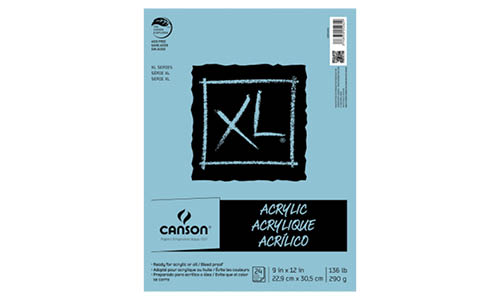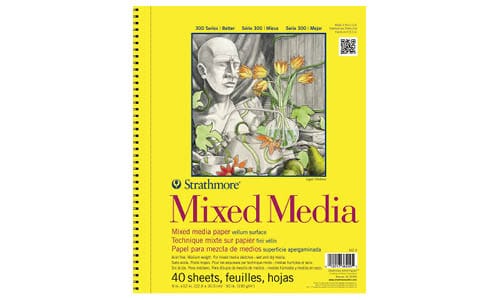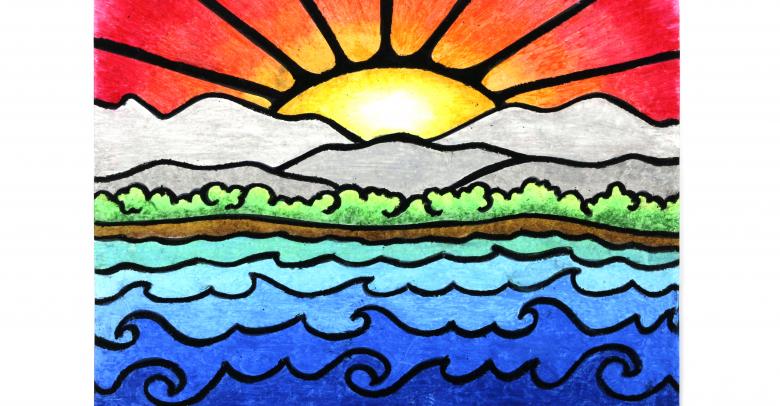For as many various medium options that you have in a work of mixed media, you have almost as many options when selecting your mixed media pad. Choosing the right paper is key to the art project outcome. Give your students the best chance at success by pairing the right media pad with each of your lesson plans.
Paper Weight and Media Pad Features to Know
Paper Weight
The basis weight of a paper listed in the description is based on the weight of a ream (500 sheets) cut to a standard size (a square meter) of that paper. The more a paper weighs the more suitable it is for use with wet media. Make sure the weight of your pads paper corresponds with the medium you are using. Learn more about paper weight here.
Types of Art Paper Surfaces
These are some common paper textures you are likely to encounter when choosing paper for an art project:
Hot-Pressed Paper: this paper has been hot rolled or ironed during production to create an even, smooth surface. The smoothness allows for drawing and or painting very fine details.
Cold Pressed Paper: Light texture, the most common because of its ease of use. It reflects light well, retaining the transparent quality of watercolors. A light grain makes it easier to achieve certain details.
100% Cotton Paper: The cotton makes the paper highly resistant and soft to the touch, as well as enhancing its ability to absorb liquids. As a result, 100% cotton paper is particularly suitable for washes.
Acid Free Paper: Acid free paper guarantees resistance and stability. Only paper manufactured using acid free materials will retain its original quality and whiteness over time.
Smooth Paper: Paper with a smooth, satin-like surface for work involving a great deal of details done in pencil, with scope for adding color using marker pens.
Rough Grain Paper: An effect close to that of handmade paper. This rough grain paper helps to achieve valuable effects of texture.
Choosing Mixed Media Paper Pads
Mixed media is a visual art form that uses a variety of media in a single artwork. One finished piece uses several mediums such as ink, colored pencil and gouache. A collage and assemblage is also an example of mixed media.
These quality mixed media pads serve as an excellent surface for complex, layered artwork:
Mixed Media Pads for Acrylic Paint Projects
While canvas is the most common choice for acrylic paint projects, paper can be a more affordable and versatile option. Both smooth and rough papers can stand up to paint, but more textured paper requires more pigment to cover the surface.
Heavy weight paper will allow more manipulation and layering, while thinner paper is more likely to tear or wrinkle because of the wet paint.
Mixed Media Pads for Watercolor Paint Projects
There are three types of paper that work well with watercolor paint: hot-press, cold-press, and rough. Hot-press paper is smooth and hard, making it an excellent option for detailed work. Cold-press paper is more textured and can work well for both washes and detail work. Rough paper has the most texture and works well for creating washes.
All three options are made for water-based media, but the type you use should be dictated by the style and goals for the outcome of the project.
Mixed Media Pads for Pencil & Colored Pencil Projects
Both graphite pencil and colored pencil can be applied to a wide range of media pads. For projects that are anticipated to require a lot of shading, blending, or erasing, a heavier weight paper is the better option.
Mixed Media Pads for Dry and Oil Pastels
Dry and charcoal pastels are dusty and will be easiest to control on a rough or “toothy” paper. A heavy paper can be important for projects that require a lot of blending.
Oil pastels also work best on rough media pads, but because of the oil, can also be used on smooth paper. They remain workable on the media surface for a long time, allowing for lots of layering and blending. For this reason, however, even heavier paper will perform best.
More Art Supplies 101 Tips & Teacher Favorites
Looking for more tips and suggestions for the art supplies your students need? Looking for lesson plan ideas to spark their imagination & inner artist? Be sure to head over to the Arts & Crafts topic page to find the latest posts.

















Leave a Reply